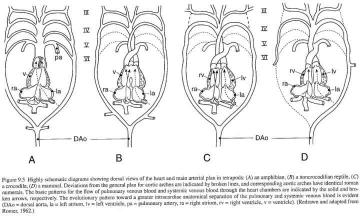Crocodilian hearts
Summary of problems:
We gain insight into heart evolution by looking across multiple animal groups. The crocodile heart demonstrates that evolutionary processes are not linear (with distinct steps from 2 to 3 to 4 chambers), but are branching processes, which produces a range of final results from a common ancestral condition. This is exactly the evolutionary prediction. Explore Evolution confuses matters by claiming this transition was difficult, reinforcing a common misconception about evolution. Crocodiles independently evolved a 4-chambered heart, demonstrating how easy that transition was, not (as Explore Evolution claims) how difficult it was.Full discussion:
 Different kinds of 4-chambered hearts: The lineage leading to crocodiles evolved a four-chambered heart along a different pathway than mammals, keeping both systemic arches.
Different kinds of 4-chambered hearts: The lineage leading to crocodiles evolved a four-chambered heart along a different pathway than mammals, keeping both systemic arches.From Figure 9-5, p. 112 of: Farrell, A. P. (1997). "Evolution of cardiovascular systems: Insights into ontogeny". Development of cardiovascular systems: molecules to organisms. Burggren, W. W. and Keller, B. B., Eds. Cambridge, UK ; New York, NY, USA, Cambridge University Press: 101-113.
The sidebar ["A Heart-to-Heart Connection?"] distinguishing crocodilian hearts from mammalian hearts is a Straw Man fallacy. Biologists do not claim that the crocodilian heart is ancestral to the mammalian heart, nor that the crocodilian heart's four chambers are the same as the mammalian heart's four chambers. For instance, Liem and Walker (2001) explain "Superficially, the mammalian heart resembles those of birds and crocodiles, but the interventricular septum evolved independently and develops embryonically in a slightly different way, so it is not homologous to the interventricular septum of these vertebrates" (Liem, Karel F. and Walker, Warren F. 2001. Functional anatomy of the vertebrates: an evolutionary perspective. Fort Worth, Harcourt College Publishers).
As illustrated in the first figure above (compare hearts C and D of "A detailed view of the heart and aortic arches"), the crocodilian heart is a slight modification of the ancestral reptilian state. So is the mammalian heart, and the bird heart. The bird heart is similar to the crocodilian heart, as Liem and Walker explain: "the ancestors of birds had a heart and pattern of aortic arches similar to that of crocodiles. Because birds evolved endothermy and lungs that are continuously ventilated, shunts bypassing the lungs--as found in crocodiles--would have had no adaptive value. Equal volumes of blood are sent to the lungs and body at all times, which appears to have been simply the result of the loss of the left systemic arch." This hierarchical pattern of similarities is exactly what would be expected from an evolutionary process.
No one portrays the crocodilian heart as an ancestral form of the mammalian heart (or at least Explore Evolution offers no example of anyone making that claim). Either the authors of Explore Evolution are not familiar with the scientific literature on this topic or they are ignoring these studies in their campaign to raise doubts about evolutionary biology.
